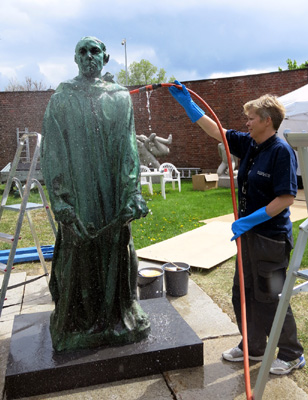
Before treatment, this sculpture had been displayed outside for more than a century

Detail of the surface showing corrosion of the bronze surface

The brown deposits at the base are probably the result of iron dust from overhead tramlines in Oslo

Senior conservator Lily Vikki washing the sculpture before treatment

Some areas of corrosion were mechanically removed with micro scalpels to improve the overall visual appearance

Testing different waxes on the bronze surface

Hot waxing the bronze surface

Front view of the treated sculpture

Back view of the treated sculpture

Detail of the head after treatment. The appearance of corrosion steaks has been reduced so that the sculpture appears closer to the artist’s intent

Auguste Rodin
'Jean d’Aire' 1884
This bronze sculpture is part of Rodin’s series ‘The Burghers of Calais’. It was commissioned as a monument to a group of 14th century citizens of Calais who offered themselves as hostages to King Edward III of England in order to spare their town, which he was holding under siege. This figure of Jean d’Aire, taken from Rodin’s original group of figures, is fabricated using roman joints from a number of sand cast bronze sections.
It was unveiled in the Frogner district of Oslo in 1902 and had been displayed outdoors for 115 years. During this time it had been washed but not waxed until very recently. The surface of the sculpture exhibits marked signs of weathering. Visual and chemical examinations confirmed the presence of a varied array of corrosion products that had resulted in extreme visual contrasts between green and black surface corrosion. In addition, there were brown deposits on upper surfaces that may have originated as fragments from overhead steel tramlines. From an aesthetic point of view these contrasts were extremely distracting and made it difficult to read Rodin’s intent for the figure.
Prior to our treatment the conservator Helena Strandberg carried out a detailed technical examination using a range of conventional analytical techniques including XRF, SEM/EDX and XRD. Short wavelength infrared (SWIR) hyperspectral imaging was also used. This is a non-contact technique that allows detailed mapping of the corrosion products on a sculptural surface, though its application in this context is extremely new. At the beginning of the treatment we met with Emilio Catelli, who was based at the Norwegian University of Science and Technology and had collaborated with Ms Strandberg in these analyses, so that we could discuss the results in more detail. Ms Strandberg’s background research seemed to point towards the possibility that the sculpture was originally patinated bluish green. This initial patination had now been replaced by natural weathering corrosion, but it was decided that the treatment should aim to reveal as much green colouration as possible so that the finished sculpture would more closely represent the artist’s intention for the sculpture. This green appearance would also chime with the aesthetic of other bronze sculptures in the city.
The black crusts contained chlorides that might contribute to further deterioration in future. The aim was to reduce black corrosion products as far as possible without removing original surface detail or revealing underlying metal. The sculpture was washed, and tests were carried out to determine the most effective techniques for removing black crusts. We concluded that the fragility of the surface coupled with the varied nature of the corrosion products required an extremely detailed approach to cleaning, using magnification. This made it possible to assess differences between corrosion products and ensure that we did not over clean the surface.
A great deal of research on waxes in the local environment has been carried out over the last 20 years by conservators at the Vigeland Museum and also at the City of Oslo Art Collection. This has given them valuable experience in this area and after discussion and practical tests we agreed that a combination of two microcrystalline waxes with high melting points would be most suitable to protect the Rodin from the effects of Norway’s changeable climate.
The treatment has been successful in cleaning the surface of the sculpture and removing a large proportion of the damaging and disfiguring encrustations and corrosion products that were originally present. The wax system has saturated the surface and visually integrated the overall appearance of the figure. This was aided by the judicious application of pigmented waxes in some areas to further unify the surface colouration. The original aim of revealing the green tone of the bronze has been achieved and the finished sculpture has a rich, dark green colour overall.
With thanks to:
Lily Vikki at Oslo kommune who assisted with this project.
Emilio Catelli, from the Norwegian University of Science and Technology, for his assistance with analysis.
Artist | Auguste Rodin |
|---|---|
Name | 'Jean d’Aire' 1884 |
Client | Oslo kommune |
Location | Oslo |